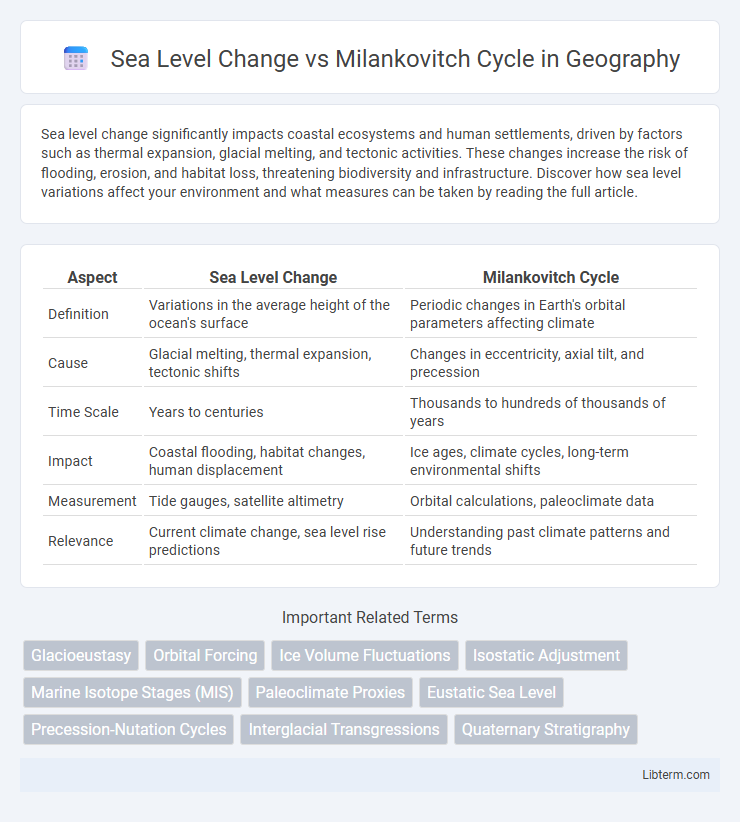Sea level change significantly impacts coastal ecosystems and human settlements, driven by factors such as thermal expansion, glacial melting, and tectonic activities. These changes increase the risk of flooding, erosion, and habitat loss, threatening biodiversity and infrastructure. Discover how sea level variations affect your environment and what measures can be taken by reading the full article.
Table of Comparison
| Aspect | Sea Level Change | Milankovitch Cycle |
|---|---|---|
| Definition | Variations in the average height of the ocean's surface | Periodic changes in Earth's orbital parameters affecting climate |
| Cause | Glacial melting, thermal expansion, tectonic shifts | Changes in eccentricity, axial tilt, and precession |
| Time Scale | Years to centuries | Thousands to hundreds of thousands of years |
| Impact | Coastal flooding, habitat changes, human displacement | Ice ages, climate cycles, long-term environmental shifts |
| Measurement | Tide gauges, satellite altimetry | Orbital calculations, paleoclimate data |
| Relevance | Current climate change, sea level rise predictions | Understanding past climate patterns and future trends |
Introduction to Sea Level Change
Sea level change primarily results from the thermal expansion of seawater and the melting of glaciers and ice sheets, influencing coastal ecosystems and human settlements. Variations in Earth's orbit, known as Milankovitch cycles, drive long-term climate shifts that modulate ice volume and sea level over tens of thousands of years. Understanding the interplay between sea level dynamics and orbital forcing is crucial for predicting future coastal impacts amid ongoing climate change.
Understanding the Milankovitch Cycle
The Milankovitch Cycle describes periodic variations in Earth's orbital parameters, including eccentricity, axial tilt, and precession, which influence long-term climate patterns. These cycles drive shifts in solar radiation distribution, leading to glacial and interglacial periods that significantly impact global sea level changes. Understanding the Milankovitch Cycle is essential for interpreting past sea level fluctuations and predicting future trends related to Earth's climate system.
Historical Patterns of Sea Level Fluctuations
Historical patterns of sea level fluctuations closely align with Milankovitch cycles, which are periodic variations in Earth's orbit affecting solar radiation distribution. These cycles, including eccentricity, obliquity, and precession, drive glacial and interglacial periods, causing significant sea level changes over tens of thousands to hundreds of thousands of years. Geological records, such as sediment cores and coral terraces, show recurring sea level rises and falls of up to 120 meters corresponding to these orbital patterns.
Mechanisms Driving Milankovitch Cycles
Milankovitch cycles are driven by periodic variations in Earth's orbital eccentricity, axial tilt, and precession, which alter the distribution and intensity of solar radiation reaching the planet. These orbital changes influence glacial and interglacial periods, causing significant fluctuations in global ice volume and consequently sea level. Variations in solar insolation patterns directly affect climate systems, triggering long-term sea level changes through ice sheet growth and melting.
Relationship Between Earth’s Orbit and Climate
The Milankovitch Cycle describes variations in Earth's orbit and axial tilt that influence solar radiation distribution, directly impacting global climate patterns and driving sea level changes through glacial and interglacial periods. Eccentricity, obliquity, and precession alter the intensity and timing of sunlight, leading to temperature fluctuations that trigger ice sheet growth or melting, thus affecting sea levels worldwide. This orbital forcing mechanism explains the rhythmic rise and fall of sea levels over tens of thousands of years, correlating closely with paleoclimate records.
Sea Level Responses to Orbital Variations
Sea level changes are intricately linked to Milankovitch cycles, which describe periodic variations in Earth's orbit affecting solar insolation and climate patterns. These orbital variations drive glacial and interglacial periods, causing large-scale ice sheet growth or melting that directly influence global sea levels. Proxy records and model simulations reveal that sea level responses typically lag orbital forcing by several thousand years, reflecting the slow dynamics of ice sheet adjustments.
Evidence from Geological Records
Geological records show that sea level changes closely correspond with Milankovitch cycles, driven by variations in Earth's orbital parameters. Sedimentary deposits and oxygen isotope ratios from ice cores reveal periodic glacial-interglacial cycles aligned with eccentricity, obliquity, and precession cycles approximately every 100,000, 41,000, and 23,000 years. These data confirm that Milankovitch-driven climate fluctuations result in significant sea level oscillations recorded in stratigraphic sequences worldwide.
Comparing Past and Present Sea Level Trends
Past sea level changes closely align with Milankovitch Cycles, which are long-term variations in Earth's orbit and tilt driving glacial and interglacial periods, causing sea levels to fluctuate by up to 120 meters over hundreds of thousands of years. In contrast, present sea level rise is occurring at an accelerated rate, approximately 3.6 millimeters per year since the late 20th century, primarily due to anthropogenic global warming rather than orbital variations. This rapid modern increase surpasses historical rates linked to Milankovitch-induced climate changes, highlighting the significant impact of current human activity on sea level trends.
Climate Feedbacks Linking Both Phenomena
Sea level change and Milankovitch cycles are intricately connected through climate feedback mechanisms involving ice sheet dynamics, greenhouse gas concentrations, and ocean circulation patterns. Variations in Earth's orbital parameters trigger glacial-interglacial cycles, influencing ice volume and consequently global sea levels by altering albedo and atmospheric CO2 levels. Feedback loops such as ice-albedo effects amplify temperature changes, linking orbital forcing to long-term sea level fluctuations observed in paleoclimate records.
Implications for Future Climate Predictions
Sea level change driven by polar ice melt and thermal expansion offers critical data for understanding future climate impacts, contrasting with Milankovitch cycles which operate on tens of thousands of years and influence long-term glacial and interglacial periods. Integrating satellite altimetry measurements of contemporary sea level rise with Milankovitch-induced insolation variations allows scientists to refine climate models, highlighting vulnerable coastal regions and predicting more immediate climate responses. Future climate predictions increasingly rely on coupling short-term anthropogenic sea level trends with Milankovitch cycle projections to enhance accuracy in risk assessment and adaptation strategies.
Sea Level Change Infographic

 libterm.com
libterm.com